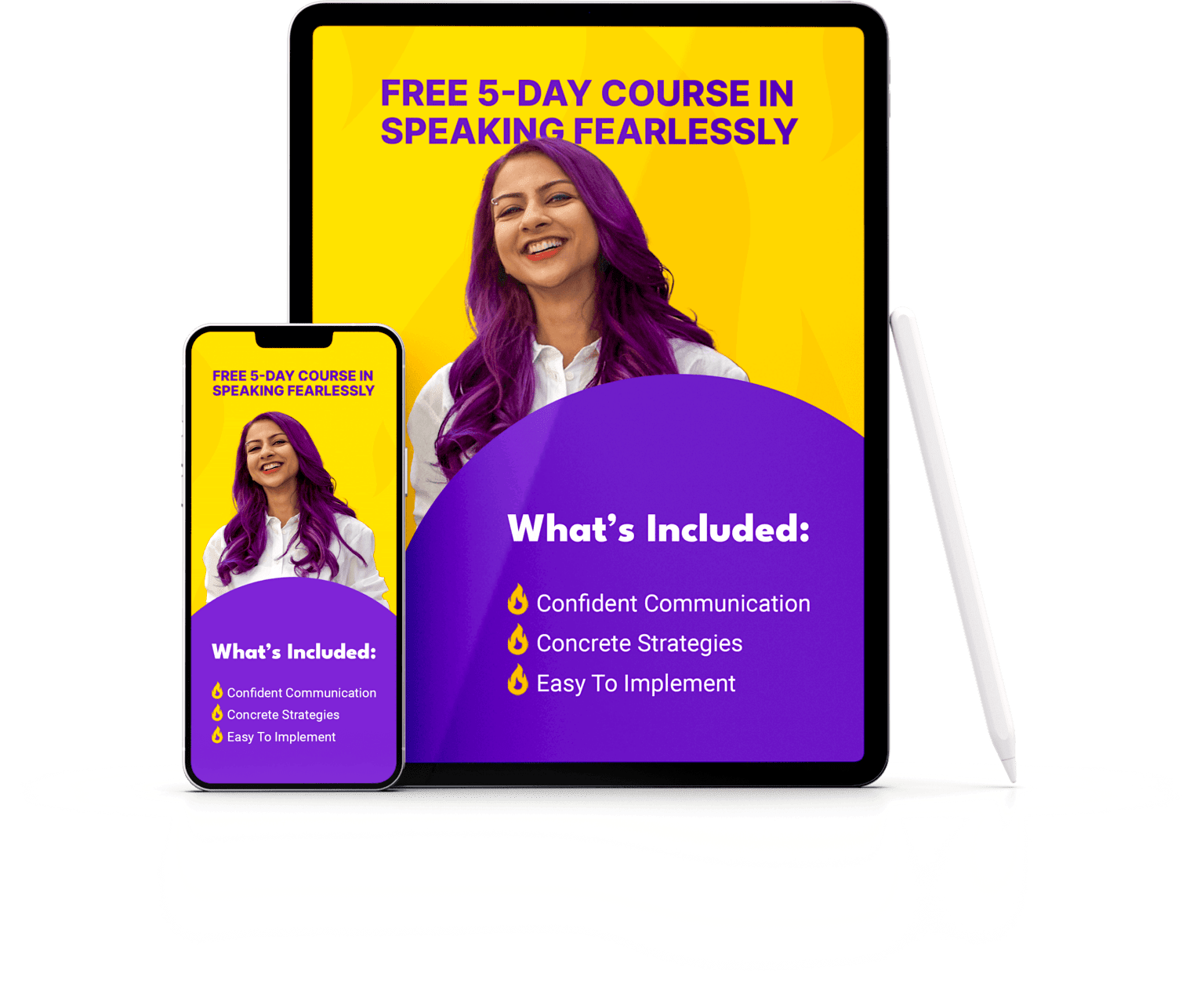Think public speaking is all about meticulous prep and well-crafted speeches? Guess again. The best mindset for speaking in public is actually about tapping into something more organic and less predictable.
As a speaking coach, you’d be surprised that most people who come to work with me do not struggle with creating speeches. Instead, they struggle with not feeling 100% confident when speaking in public or on camera. They would watch themselves back and feel let down by their performance. They don’t feel like they’re as impressive as they wanted to be.
I’ve spoken at 200+ events, from tiny to TEDx. In my journey, I’ve picked up a lot of tools and frameworks to continuously refine my performance. But you know what? The biggest lesson that I’ve learned from 17 years of speaking on stage and camera is this: your mindset about speaking matters far more than your presentation skills.
Using mindset-based techniques, you’ll find yourself conquering fear, feeling more at ease and captivating audiences—whether you’re speaking to a group of 20 or a crowd of 20,000.
In this guide, I’ll show you a new way to think about public speaking. This will leave you feeling not just ready but excited for your next talk, presentation or podcast.

Table of Contents
Unveiling the Best Mindset for Public Speaking
In this section, you’ll:
– Embrace the concept of growth mindset in public speaking
– Overcome fears and uncover methods to manage anxiety while speaking

Why is Mindset Important in Public Speaking?
Mindset plays a significant role in how we approach public speaking. For instance, a fixed mindset might view public speaking as an innate ability – you either have it or you don’t.
In contrast, a growth mindset says that skills can be learned. This leads to a more effective public speaking performance. The belief that you can improve and evolve your public speaking skills, irrespective of your current level, is the foundation for growth and achievement.
According to David Yeager, PhD, an associate professor of developmental psychology at the University of Texas at Austin, “Growth mindset is the belief that a person’s intelligence and abilities can grow and improve with practice, and researchers have found that brief exercises that increase growth mindset can help keep a person motivated and improve.”
The Power of Growth Mindset in Public Speaking

The growth mindset is a belief system where skills and abilities can be developed with practice and effort. There is no limit to how much you can learn and improve at any skill.
When applied to public speaking, this can mean the difference between sweaty palms of fright and confidently owning the stage.
The truth is, public speaking is something you can learn, not something you were born good at!
A fixed mindset would say, “I am not born to be a talented speaker” or “I’m too introverted to speak in public”.
A growth mindset says, “I can learn what it takes to be a better speaker”. “My introversion doesn’t stand in the way of me being the best speaker I can be”.
Successful public speakers like Simon Sinek or Brené Brown share a common trait: they all embrace a growth mindset. They’ve reached the top through years of hard work, practice and stepping out of their comfort zones.

How to Develop a Growth Mindset for Public Speaking
Developing a growth mindset for public speaking emerges from understanding that skills can be honed, and ability isn’t finite.
Here’s how you can develop a growth mindset when you speak in public:
- Aim to develop a preparation routine that includes positive self-talk. You could use the Judge Judy method to challenge negative thoughts.
- Recognize that setbacks aren’t failures but opportunities for learning.
- Aim to develop an understanding of both your skills as well as opportunities.
- Seek out feedback on your speaking skills and value it as a guide for learning, not a marker of weakness.
- Set achievable goals and aim to progressively work towards them.
Overcoming Fear: The First Step to Mastering Public Speaking
The number one phobia in the world is reportedly the fear of public speaking. Even death only comes second. This feeling of anxiety is a common challenge when speaking in public: whether it’s because you worry about being judged, making mistakes, or you don’t know what to expect.
There are specific strategies that can help in conquering these fears. Check out this article where I discuss techniques such as visualization, deep breathing, and intentionally altering negative thought patterns.
These strategies contribute immensely to soothing nerves and easing anxiety. By using them consistently, you can turn your fear into something that drives you to become an impactful public speaker.
Enhancing Your Public Speaking Skills with the Right Mindset
– Practice the art of mindfulness in your presentation.
– The way you frame your mindset is a crucial aspect in public speaking.
– Learn strategies on how to reframe your mindset and excel in public speaking.
The Art of Mindful Presenting
Mindful presenting entails remaining present and focused during your delivery. This is easier said than done, but extremely crucial in building your confidence, self-belief and stage presence.
This mental state also minimizes the risk of being preoccupied with negative thoughts or anxieties, improving the overall quality of the presentation.

Nausheen Chen on TEDx stage
Embodying mindfulness means being fully present and 100% aware of yourself and your audience when you present. This way you make a deeper connection with your audience, command their attention and can easily adapt to changing circumstances.
Practicing mindfulness in public speaking is not as daunting as it may seem. A simple practice to start with is focusing on your breath. It helps keep you grounded and present while speaking. Visualization exercises, such as visualizing a successful delivery when prepping, provide another powerful tool for mindful presenting.
| The Writer/Actor Reframe for Public Speaking Very often, I find that my clients start editing themselves as they speak. They rethink what they started their sentences with midway through, and abandon them in favor of new thoughts. They go off on tangents and ramble. They get lost and often ask: “Did that answer your question?” An effective way to stay on track and 100% present when speaking is to think of yourself as the “actor” rather than the “writer”. Think of it as a film set. The writer’s job is to hand the actor the script and let them perform it. But if the writer constantly comes and interrupts the actor with new thoughts, the actor will never be able to deliver an impactful performance. Let the “writer” in you feed you the initial prompt. And then let the speaker take over and bring that thought to life. You’ll find yourself being much more present in the moment. You’ll then be able to focus on delivering your message in a more impactful and powerful way. |
Reframing Your Nerves: A Key to Successful Public Speaking
Reframing your nerves before a big talk involves shifting your perspective, particularly in relation to fear or anxiety associated with public speaking. Rather than viewing public speaking as a fear-inducing task, reframe it as an opportunity to communicate valuable insights and engage with your audience.
Reframing your mindset helps immensely: Not only do you present better but you will also feel much more positive about speaking in the future.
When I got a “yes” for my first TEDx talk, you can imagine how excited I was. But, truth be told, it was short-lived. In just about 10 seconds, I felt immediate dread. I felt like an imposter, like they’d somehow made a mistake in choosing me. The fear of letting myself and everyone else down on that prestigious TED stage was overwhelming.
But then, something shifted when I realized it was just nerves—plain old nerves. So, I decided to reframe them. Instead of dread, I told myself I was feeling excitement. Excitement to share my story with such a large audience. Excitement at the thought that maybe my words could touch someone’s life in a positive way.

Nausheen Chen on TEDx stage
Once I made that mental switch, everything changed. I stepped onto that stage not as a bundle of nerves, but as someone genuinely thrilled for the opportunity to connect and inspire. Reframing my nerves as excitement made me push through and deliver a talk I’m truly proud of.
There’s no one-size-fits-all approach to reframing your mindset. It varies significantly from person to person. However, some strategies may include challenging negative thought patterns, adopting power poses before you speak, and incorporating positive affirmations into your daily routine.
Reframing Your “Performance” when you speak in public
When you present to an audience, you’re not there to be judged.
You’re not there to impress.
You’re simply there to communicate a message – be heard, understood and remembered.
Aim to change the way you’re approaching the next keynote, the next podcast or webinar. Are you thinking of it as an opportunity to impress instead of making a real connection? You might be putting too much undue pressure on yourself that way.
Aim to reframe your next speaking opportunity: it’s a chance to get your message heard. It’s a chance to build a connection with the audience and to share something that will help someone in their work or life.
This simple reframe helps take the pressure off and lets you do what you do best: share your message and expertise.
Building Confidence: The Ultimate Mindset for Public Speaking
– Confidence is a turning point in mastering public speaking.
– Self-talk molds your confidence, making it an invaluable tool.
– Learn to build and harness these twin powers to improve your speeches.
The Role of Confidence in Public Speaking

Confidence is the backbone of compelling public speaking. It’s the silent tool that transforms simple presentations into persuasive dialogues. With confidence, you can command not only attention, but respect, understanding and influence. Yet, building confidence isn’t an overnight task. It requires consistent effort, preparation and a lot of positivity.
The good news is, confidence is something everyone can work on. Even thought leaders who seem naturally confident when they talk have the need to feel more secure. It’s not enough that they know their topics well. They need to be able to convey that message in an impactful way – one that can influence the audience.
The better you a’re at articulating your thoughts, the more confident you’ll feel about your delivery. Here’s where the strategies on using body language, tone of voice and words enter the mix.

Psychologist Albert Mehrabian studied the relative importance of these three elements in our communication: words, tone of voice and body language. Even though this model has been revised and questioned – the reality is that focusing on your tone, your energy and body language can greatly enhance your message.
The Impact of Positive Self-Talk on Public Speaking
Positive self-talk, in many ways, is the cornerstone of confidence. Your internal monologue has the potential to either make or break your speech. Constructive conversations with oneself have the power to not only build confidence but also to keep nervousness at bay.

Here’s how it works:
When you engage in positive self-talk, you’re laying the groundwork for self-confidence. By instilling belief in your abilities, these simple affirmations motivate you to perform. The more positively you speak to yourself, the better you tend to perform.
Now, how do you practice positive self-talk?
The first step is noticing your self-dialogue. Be aware of the nature of your thoughts. Recycle any negative thoughts into positive affirmations. Instead of saying, “I will never get this right!” try saying, “I am doing the best I can.” Small changes in your self-dialogue can foster a positive mindset and boost your confidence.
Simultaneously, visualize your success. Picture yourself delivering a successful speech. Feel the applause and savor the joy. Visualization combined with positive self-talk can increase your confidence significantly.
By integrating these strategies into your preparation routine, positive self-talk can greatly complement your public speaking by enhancing your confidence.
Here’s how my friend Marco Andre deals with his negative voices and makes them work for him, instead of against him.
Redefining Public Speaking
– Master public speaking to expand your professional world.
– Understand the importance of mindset, and leverage the power of practice.
– Capitalize on resources to become a more effective communicator.
Challenge the definition of “public speaking”
Most people think public speaking is speaking on a big stage, behind a podium. But if you only look at these “typical” events to build your public speaking skills, you’re losing out.
The best way to improve your public speaking skills is to think of every team meeting, every podcast, every webinar as public speaking. Use any opportunity possible to practice the mindset shifts and reframes that we discussed in this article.
The Role of Practice in Mastering Public Speaking
Much like any other skill, public speaking is improved significantly by practice. It’s through repetition and reflection that we gradually refine our skills, with early-stage mistakes becoming our lessons to improve exponentially. We practice and refine your speaking skills together in the Speak As A Leader Bootcamp.
Conclusion
Establishing a connection with your audience makes your talk more memorable instead of just trying to win them over. It’s about inviting your audience to join you on your journey rather than just watching you perform.
Use this perspective to turn public speaking dread to delight. Aim to take the focus away from fear and nerves and think of the stage as a place to connect, talk and team up with your audience.
So, next time you’re on that stage, remember – it’s not a battlefield, it’s a conversation. A simple shift in perspective can transform your approach and make you more accepting of situations that might have otherwise terrified you.
Now, how would you use this mindset to change the way you approach your next presentation, meeting or podcast? Let’s talk.

